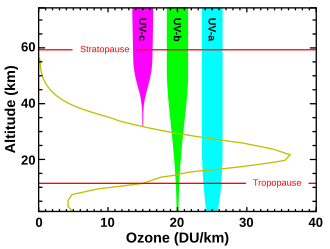Ultraviolet







Ultraviolet (UV) is a form of electromagnetic radiation with a wavelength from 10 nm to 400 nm, shorter than that of visible light but longer than X-rays. UV radiation is present in sunlight, and constitutes about 10% of the total electromagnetic radiation output from the Sun. It is also produced by electric arcs and specialized lights such as mercury-vapor lamps, tanning lamps, and black lights.
Properties[edit]
Ultraviolet radiation is divided into several subtypes, including UVA, UVB, and UVC, based on their wavelength. UVA has the longest wavelengths, followed by UVB, and UVC has the shortest. UVC is mostly absorbed by the Earth's atmosphere and does not reach the surface.
Effects on Health[edit]
Exposure to UV radiation can have both beneficial and harmful effects on human health. It is essential for the production of vitamin D in the skin, but excessive exposure can lead to skin damage, sunburn, and increased risk of skin cancer. UV radiation can also cause damage to the eyes, leading to conditions such as cataracts.
Applications[edit]
Ultraviolet light has various applications in different fields:
- Medical and Sterilization: UV light is used for sterilizing medical equipment and in water purification systems due to its ability to kill bacteria and viruses.
- Forensics: UV light is used in forensic investigations to detect bodily fluids and other substances that fluoresce under UV light.
- Industrial: UV curing is used in the manufacturing of polymers and inks.
- Astronomy: UV astronomy is used to observe astronomical objects in the ultraviolet spectrum.
Environmental Impact[edit]
The ozone layer in the Earth's stratosphere absorbs most of the Sun's harmful UV radiation. Depletion of the ozone layer due to human activities has led to increased UV radiation reaching the Earth's surface, with potential impacts on ecosystems and human health.
Gallery[edit]
-
Erythemal action spectrum showing UV effects on skin.
-
Diagram of DNA mutation caused by UV radiation.
-
Sunscreen protecting against UV and visible light.
-
Warning sign for UV radiation.
-
Rope damage due to UV exposure.
-
Infrared and UV spectrum comparison.
-
Portrait under UV light.
-
Jupiter's aurora captured in UV light.
-
UV security features on a credit card.
-
UV screening for hazardous materials.
-
Minerals fluorescing under UV light.
-
UV effects on wood finish.
-
UV disinfection in a laminar flow cabinet.
Related Pages[edit]
Ad. Transform your life with W8MD's Budget GLP-1 injections from $75


W8MD offers a medical weight loss program to lose weight in Philadelphia. Our physician-supervised medical weight loss provides:
- Weight loss injections in NYC (generic and brand names):
- Zepbound / Mounjaro, Wegovy / Ozempic, Saxenda
- Most insurances accepted or discounted self-pay rates. We will obtain insurance prior authorizations if needed.
- Generic GLP1 weight loss injections from $75 for the starting dose.
- Also offer prescription weight loss medications including Phentermine, Qsymia, Diethylpropion, Contrave etc.
NYC weight loss doctor appointmentsNYC weight loss doctor appointments
Start your NYC weight loss journey today at our NYC medical weight loss and Philadelphia medical weight loss clinics.
- Call 718-946-5500 to lose weight in NYC or for medical weight loss in Philadelphia 215-676-2334.
- Tags:NYC medical weight loss, Philadelphia lose weight Zepbound NYC, Budget GLP1 weight loss injections, Wegovy Philadelphia, Wegovy NYC, Philadelphia medical weight loss, Brookly weight loss and Wegovy NYC
|
WikiMD's Wellness Encyclopedia |
| Let Food Be Thy Medicine Medicine Thy Food - Hippocrates |
Medical Disclaimer: WikiMD is not a substitute for professional medical advice. The information on WikiMD is provided as an information resource only, may be incorrect, outdated or misleading, and is not to be used or relied on for any diagnostic or treatment purposes. Please consult your health care provider before making any healthcare decisions or for guidance about a specific medical condition. WikiMD expressly disclaims responsibility, and shall have no liability, for any damages, loss, injury, or liability whatsoever suffered as a result of your reliance on the information contained in this site. By visiting this site you agree to the foregoing terms and conditions, which may from time to time be changed or supplemented by WikiMD. If you do not agree to the foregoing terms and conditions, you should not enter or use this site. See full disclaimer.
Credits:Most images are courtesy of Wikimedia commons, and templates, categories Wikipedia, licensed under CC BY SA or similar.
Translate this page: - East Asian
中文,
日本,
한국어,
South Asian
हिन्दी,
தமிழ்,
తెలుగు,
Urdu,
ಕನ್ನಡ,
Southeast Asian
Indonesian,
Vietnamese,
Thai,
မြန်မာဘာသာ,
বাংলা
European
español,
Deutsch,
français,
Greek,
português do Brasil,
polski,
română,
русский,
Nederlands,
norsk,
svenska,
suomi,
Italian
Middle Eastern & African
عربى,
Turkish,
Persian,
Hebrew,
Afrikaans,
isiZulu,
Kiswahili,
Other
Bulgarian,
Hungarian,
Czech,
Swedish,
മലയാളം,
मराठी,
ਪੰਜਾਬੀ,
ગુજરાતી,
Portuguese,
Ukrainian










